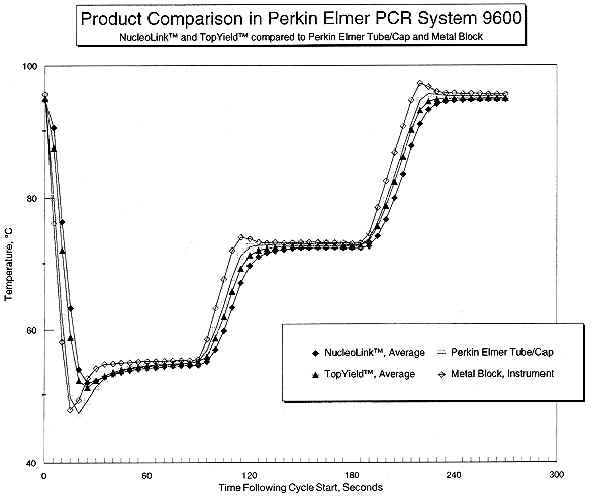TechNote Volume 3 No. 18 - Thermal Profiles of Liquid in NucleoLink
NucleoLink™ strips are designed to allow solid phase amplification followed by detection in the same vessel ![]() )
)![]() )
)![]() )
)
Extensive tests on the physical functionality of NucleoLink™ and TopYield™ strips conducted by evaluating the thermal profiles of liquid thermocycled in the Perkin Elmer 9600 thermal cycler demonstrate that they can be used interchangeably with the Perkin Elmer tube/cap system for standard amplification. Thermal cycling parameters standardized for solution phase amplification in the TopYield™ strips may easily be transferred to the NucleoLink™ strips. The independent studies on the functional performance of these strips are presented below; ( i.e., the polymerase chain reaction of DNA template) strongly verify their utility as standard reaction vessels for amplification.
The studies were designed to evaluate the heat transfer efficiency of NucleoLink™ and TopYield™ strips when thermocycled with 50 µl of water in the Perkin Elmer 9600 thermal cycler. Comparison of thermal profiles achieved with the Perkin Elmer tube/cap system in the Perkin Elmer 9600 block demonstrates the physical similarity in heat transfer between NucleoLink™ and TopYield™ strips with the Perkin Elmer thin wall tubes. The data supports the contention that the NucleoLink™ and TopYield™ strips are interchangeable with the Perkin Elmer thin wall tubes in their ability to support standard DNA amplification in the Perkin Elmer 9600 thermal cycler ![]() )
)
Materials and Methods
Six wells each from the NucleoLink™ and TopYield™ strips and Perkin Elmer thin wall tubes filled with 50 µl of water were placed directly into the Perkin Elmer 9600 thermal cycler block without the Perkin Elmer tray. The liquid was thermocycled through 25 cycles, each consisting of one minute dwell at 94ºC, one minute at 55ºC and one minute at 72ºC with a pause of five minutes at 94ºC after set point 1 in cycle 1. Fine gauge, bare wire thermocouples were used (0.005 inch diameter wires with exposed junction) to permit the most rapid response possible. A 'K' welded junction of 'chromel' nickel-aluminum alloy and 'Alumel' nickel-aluminum alloy was used to permit direct exposure to hot water without galvanic errors. The signal from the thermocouples was read on a digital volt meter with 'K' thermocouple scale (A-W Sperry DM-6200). All readings were on the 200ºC scale, readable to one decimal place. Strips were sealed during cycling by placing a silicone rubber ![]() )
)
Results and Discussion
Temperatures for each of the six wells for each tube type were recorded. Each well was evaluated in only one cycle. An average of all the six readings was plotted for each of the strips and the Perkin Elmer thin wall tube for all the readings taken during the entire cycle.
A comparison of these temperature profiles for the NucleoLink™ and TopYield™ strips sealed with a silicone rubber pad described above, and the Perkin Elmer tube/cap system and the thermal cycler block is shown in the graph below. The superimposed curves suggest that in both the cooling and heating curves, a temperature lag of approximately 10 seconds for NucleoLink™ strips is apparent, relative to the metal block. It is important to note that despite the fact that this lag exists in the ramping phase of both the cooling from 94ºC to 55ºC and heating from 55ºC to 72ºC and also 72ºC to 94ºC, the liquid in both the TopYield™ and NucleoLink™ strips held steady at the approximate set temperatures of 55ºC, 72ºC and 94ºC for the entire one minute dwell times. The thermal profiles clearly support the functional utility of these strips. Thus, no additional adjustments in cycling parameters, such as temperature and time are necessary in the amplification of generic DNA templates.
 Figure 1: Product Comparison |